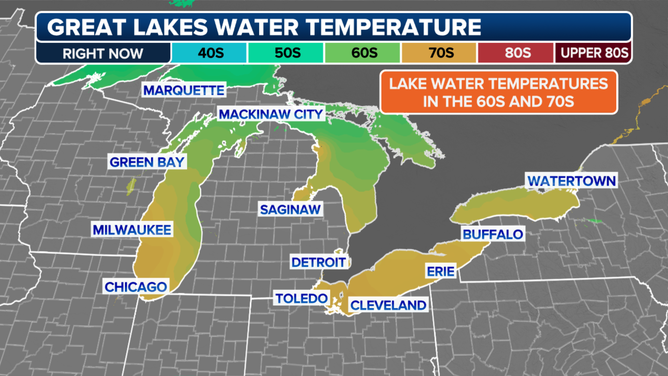Great Lakes face waterspout threat as chilly air mass moves in
Waterspout season typically runs from August through October along lakes Superior, Michigan, Huron, Erie and Ontario. During the late summer and fall, the waterways experience their warmest water temperatures of the year, which creates the necessary conditions for waterspouts.
Waterspout comes off Lake Erie into downtown Buffalo
National Weather Service video shows a waterspout coming onshore into downtown Buffalo, New York on Monday ripping part of a roof of a building on Niagara Street. (Video from August 2024)
CLEVELAND – Weather watchers along the Great Lakes have had their best chance of the year so far to spot a waterspout as a cool, fall-like air mass overtakes the warm bodies of water.
The International Centre for Waterspout Research (ICWR) had warned that conditions were to be most favorable over lakes Huron and Erie, but the possibility that nearly all the five giant lakes could see the potential for waterspouts through the weekend existed.
And as of Saturday afternoon, the ICWR said 18 waterspouts had been reported over lakes Michigan and Erie.
"The cold front, well, it has passed its way through with lake water temperatures that are sitting comfortably in the 60s and 70s," FOX Weather Meteorologist Jane Minar said. "And with that warmer water, you stack that up with some colder air that settles in behind that front, and you get a temperature contrast, a little bit of turbulence, and suddenly you have these waterspouts that begin to form."
WATERSPOUT OFF FLORIDA COAST DELAYS SPACEX ROCKET LAUNCH
A waterspout is similar to a tornado, except it forms over a body of water when there is a significant temperature contrast in the lower layer of the atmosphere.

Great Lakes water temperatures.
(FOX Weather)
In most cases, waterspouts are significantly weaker than tornadoes and quickly dissipate before making it to land.
According to the National Weather Service, the waterspouts are typically a more significant concern for boaters and marine interests than for those witnessing the occasion from the coastline.
Storm chaser Kaitlyn Jesmonth captured the sights of at least one of the twisters from a beach in Indiana.
Waterspout season typically runs from August through October, when the waterways typically experience their warmest water temperatures of the year.
Last October, a record number of waterspouts were spotted from the shores of Lake Erie, as water temperatures in the 70s helped produce pristine conditions.
A significant fall frontal boundary that pushed through the lakes helped to cool the air and trigger the phenomenon.
According to the ICWR, 188 waterspouts were spotted, but the actual number was likely around 300 as many possibly were undetected.
OVER 180 SIGHTINGS OF WATERSPOUTS AND FUNNELS REPORTED ALONG SHORES OF LAKE ERIE, RESEARCHERS SAY
Instead of Tornado Warnings, local National Weather Service offices can issue a Marine Warning to alert boaters about hazardous conditions.
In the event a waterspout’s circulation reaches the shore, the event would be classified as a tornado.
"So, boaters beware, swimmers beware. It is a dangerous threat along the Great Lakes this weekend," Minar said.
Record-breaking 188 waterspouts recorded over Lake Erie over the weekend
Wade Szilagyi, the director of the International Centre for Waterspout Research, joined FOX Weather on Tuesday to explain what’s behind the record number of waterspouts that were observed over Lake Erie over the weekend.

